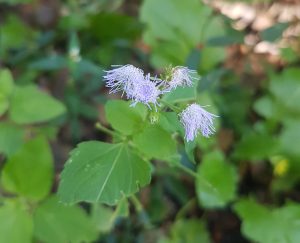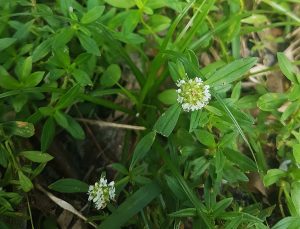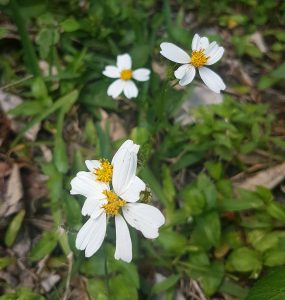
For the most part, my wife and I let our yard do its own thing. I’m not talking about the big feature plants, but rather the grass (or lack thereof) in between. In these areas, tons of small wildflowers have taken over, and the pollinators LOVE it! So, it turns out, do we. We actually don’t really talk about our lawn anymore, but rather our meadow, because that’s really what it is!
Now, I say we let the yard do its own thing “for the most part,” because we do still want it to be a place we enjoy hanging out. This means that if a particularly troublesome weed starts taking over, we will yank them all out. Some weeds definitely do need to be controlled, for either aesthetic or environmental reasons. And I do still mow it. So it’s not perfectly wild by any means, but it’s definitely a step up from the intensely manicured and non-biodiverse lawns that are so common these days.
Our insect population is testament to that fact. We have so many butterflies, bees, and other pollinators, so many spiders and beetles… you name it, we have it. Sometimes our neighbors will complain about how they don’t see as many butterflies anymore, or how there’s not as many bees in their vegetable garden. I have to sheepishly admit to them that I think they’ve all moved to our yard! But there’s still enough bugs to go around (for now)… if you build their ecosystem, they will come. Or better yet, you don’t even really have to build it… let your meadow of wildflowers build itself!
Without further ado, here are the stars of the show. Or at least, some of them… there’s too many to discuss at once, so consider this Part 1!
Florida Pusley (Mexican Clover) – Richardia scabra

This is the most abundant of our yard”s wildflowers. To be honest, I’m not sure which of the two it is (Florida pusley (Richardia scabra) vs Mexican clover (Richardia grandiflora)). They are hard to differentiate, so I won’t try to here. Despite Florida pulsey’s name, neither of them is likely native. Many locals affectionately call them our “Florida snow.” Bees and butterflies love them too!
While they’re definitely a step up from a mono-culture lawn, that doesn’t mean we want them encroaching into native habitats. In recent years, Richardia grandiflora has begun to do just that, so it has earned itself a place on the Category 2 Invasive Plant List. Category 2 means that the plant is occurring with greater frequency in wild ecosystems, but not yet altering or damaging them (as opposed to Category 1 plants, which damage the ecosystem). So I’ll let them be for now, but definitely something to keep an eye on!
Oxalis debilis – Pink Woodsorrel

Pink Woodsorrel, or Oxalis debilis, is one of the two most common oxalis in Florida (the other being Oxalis corniculata, which has a yellow blossom). I’ve got both in my yard, but the corniculata wasn’t blooming at the moment. While Oxalis corniculata is native to Florida, Oxalis debilis is not. It’s originally native to South America, but is now common worldwide. I understand why some people might not want them popping up in their lawn, but I really like their visual impact on the scene (both the flowers and the leaves). And they’re not horribly hard to remove, so if I ever stop liking them, I can easily yank them out. But for now, they get to stay!
Jack in the Bush (Chromolaena odorata)

Jack in the Bush (Chromolaena odorata), also known as Crucita or Blue Mistflower, is another good one. For me, it seems to keep to one (rather neglected) corner. However, I’ve read that it can rather aggressively take over spaces if left unchecked. I’ll keep an eye on it, but for now it’s not giving me any problems. My guess is that’s because it still gets mowed somewhat regularly.
Jack in the Bush is native to South Florida, and is a great nectar plant for many butterflies. In fact, you can buy them at many butterfly-focused nurseries that sell native wildflowers, but you’re likely to get yourself a few if you just let nature do its thing! You can read more info on them here: Jack in the Bush – Natives for your Neighborhood.
Wire Weed (Sida ulmifolia)

Sida ulmifolia, or Wire Weed, is a rather ignored (if not actively disliked) “weed,” but I quite like it. Flowers in the Sida are also known as “fanpetals,” and it’s pretty easy to see why — the petals look like the blades of a fan. Sida ulmifolia is the most common member of the genus in Florida, and is sometimes called Common Fanpetal.
Wire weed can get a few feet high, and rather woody and thick at the base. In this stage, I think they’re pretty unattractive (at least in the context of my yard), so I yank them out when they get too big. But if they’re staying low, I let them stick around as long as they want. Be careful though: they can be really hard to remove if they get too big. Sida ulmifolia is a native wildflower, and butterflies and moths love them. I don’t see too many large butterflies hanging out on them, but I do see lots of smaller nondescript types that are equally important.
Shrubby False Buttonweed (Spermacoce verticillata)

Spermacoce verticillata has to common name Shrubby False Buttonweed, which is pretty long and thus often shortened to Buttonweed, but it’s not the same as the maligned Buttonweed that is common further north. It’s native to South America, but common throughout Florida now. Same as Mexican Clover, it’s now on the Category 2 Invasive Species List, so I’ll have to keep an eye on it — keep it under control, and start yanking it out if its elevated to Category 1. Insects do seem to love it, especially the bees.
Lilac Tasselflower (Emilia sonchifolia)

Lilac Tasselflower (Emilia sonchifolia) is another common appearance. I’ve read conflicting information as to it’s origin: some say native to Florida, but some say native to Asia. It’s blooms are a really pretty lilac color, but you’ll probably never notice them. As far as wildflowers go, it’s pretty inconspicuous. They don’t open up too much more than those in the photo above (though they do open a little more). Another name for them is “Cupid’s Shaving Brush” — what a name! It is apparently edible and medicinal, but don’t take my word for it… do much more research before you try eating any weeds!
Beggar Ticks (Bidens alba)

Beggar ticks! I love the name. I don’t necessarily love the plant. They are also known as Spanish Needles, or Shepherd’s Needles. Bidens alba are VERY prolific seeders, so can quickly take over a whole yard if left unchecked. At least, they could certainly take over my whole yard. Well, I really don’t want them to take over my yard, because the seeds really cling to my dog’s fur.
But, they’re a pretty beneficial species to have in the landscape. They are native to Florida, and quite adored by pollinators, including the Florida Duskywing and Dainty Sulphur butterfly (for which it’s a larval host). They are also recognized as attracting large numbers of native bees. And birds like the seeds, too! So I like to keep some around, but I’ll typically thin them out every now and then to prevent complete takeover by these aggressive wildflowers.
Okay, that’s it for now! There’s a lot more wildflowers that pop up in the yard, so I’ll definitely make another post in the future.

1 thought on “May all your weeds be wildflowers”